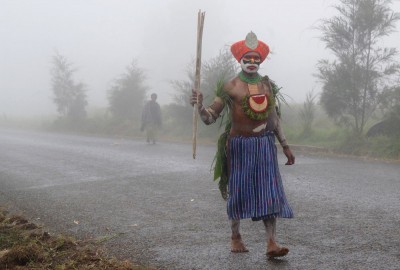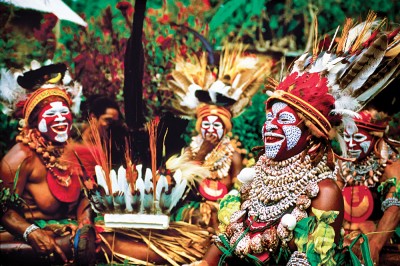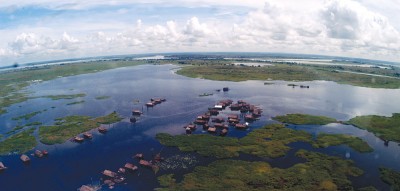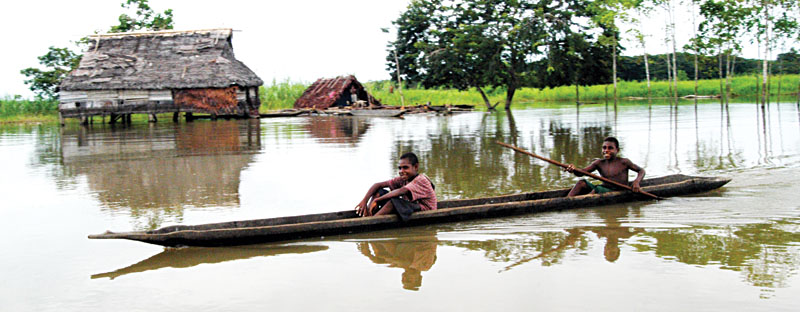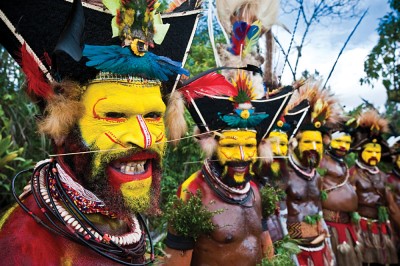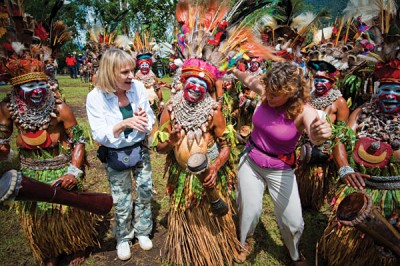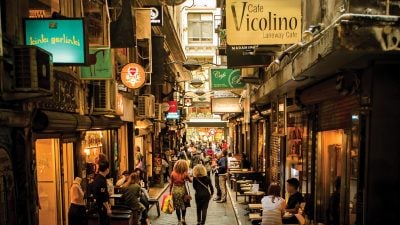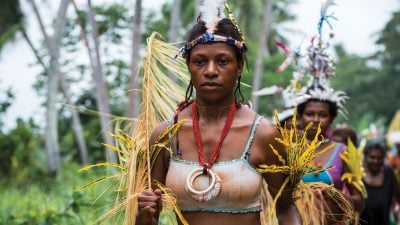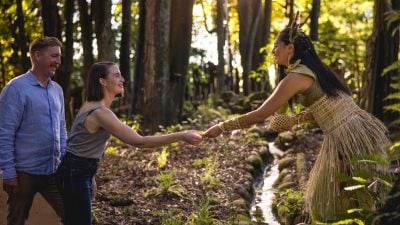Home / Australia & South Pacific / Papua New Guinea / Papua New Guinea is Truly a Ho…

Papua New Guinea is Truly a Holiday of a Lifetime
Barbara Norton, Goway’s General Manager for Groups & Special Events, is passionate about Papua New Guinea. After returning from her exploratory journey she has created a limited edition Holiday of a Lifetime tour series, “Discover Papua New Guinea”. Below is an excerpt from her travel diary and what you can expect to experience in this most fascinating country.
A trip to Papua New Guinea (PNG) has been on my “must visit” list forever, and when presented with the opportunity to travel to one of the most remote islands on earth, I jumped at the chance, not only to fulfill a lifelong dream, but also to experience this fascinating destination first-hand so I could investigate it as a new destination for our Holidays of a Lifetime program.
In a country filled with geological and cultural contrasts, my itinerary focused on 3 diverse regions: Mt Hagen in the Western Highlands, Karawari region in the Sepik River Basin, and Tari in the Southern Highlands.
I joined a small group of travellers in Northern Australia and after connecting via the capital city, Port Moresby, we flew on an Air Niugini flight to Mt Hagen where we were met and transferred up a long and winding road to our accommodation at fabulous Rondon Ridge, overlooking the stunning Wahgi Valley.
The next day we joined our guide and mini-bus driver for our first adventure which was to be one of many on this trip. We travelled by road for 2 hours into the heart of the Wahgi Valley where we spent the day at the Wahgi Sing Sing, a wondrous cultural show of dancing, singing and local merriment.
Here many local tribes come together in a stunning visual display of costumes, body colouring, music, chanting, and dancing. A local sport field was a sea of motion, sound and colour the whole day! What made this event even more fascinating was that it was not a display for tourists, in fact, we were the visual minority, as we dodged betel nut spittle, mud-spattered kids and more than few friendly stares. Our day ended with a 45 minute climb up a rock-strewn mountain to the Wahgi Guest Haus, a rustic lodge with basic facilities, but yet, a welcome respite from the day, allowing time to reflect on such an incredible sensory experience. The following day we were back to Rondon Ridge for a relaxing afternoon getting ready for our next adventure… exploring the mystical Sepik River region.
The next morning, we were off early to the Mt Hagen airport to meet our Aussie pilot for our 45 minute charter flight on a 6-seater propelled plane that took us down from the Highlands to the Sepik River Basin at Karawari, one of the Sepik’s main tributaries. From the cool, spring like weather of the Highlands, we arrived into the hot, humid conditions of this dense tropical lowland rainforest region, one of the great, untouched rainforests on the globe. After a short walk to the river, we boarded a small shuttle boat for a quick ride upriver to the stunning Karawari Lodge, our home for the next 2 nights. Not only was the Lodge built to blend in to the landscape using local materials, its remote location and setting on a ridge overlooking the river and jungle-clad basin makes it one the most unique lodges in the world.
We set off on our first adventure across the river to a small village for a Sago Palm making demonstration. Sago is the staple food of the river people and the process to get it from a tree trunk to an edible flour is very labour intensive: from chopping the wood pulp, to soaking and squeezing out the starchy residue, to draining off the water, to forming dough balls, to flattening and frying over an open fire. The end result was a bland, tortilla-like pancake that was then filled with fish or just eaten plain. Our evening was one of relaxation with a sundowner on the lodge veranda, a delicious dinner (sago optional!) and a comfortable sleep in our mosquito-netted beds.
The next day was spent travelling up and down the tributaries in the area. Life in the Sepik Region revolves around the rivers and lakes of the basin; the waterways and the land on its fringes are their lifeline, and the day to day subsistance activities are molded to their ebb and flow. As we motored our way along, the power of the river was evident in every twist and turn we took – narrow dug-out canoes glided by full of goods to trade, women fished or made sago, kids shreiked and splashed in the water, villages suddenly came in to sight and people smiled and waved wherever we looked. In the end, we visited 3 different villages each with its own unique activity to show us. In one, we watched a re-enactment of a traditional dance ceremony and observed basket weaving and bilum (handbag) making. In another, we climbed a hill to see the remnants of a Spirit House ruined in a WW2 Japanese bombing raid, and, in another, we visited the “man’s house” to view historic carvings and to learn more about the art and belief systems of the region. Being immersed for a whole day in a seemingly idyllic lifestyle that has not changed for thousands of years was deeply moving.
Our final adventure began the next morning as our 40 minute charter flight took us out of the lowlands and back up to the central mountains, this time to Tari in the remote Southern Highlands Province. Amazingly, we were now in one of PNG’s most remote, undeveloped regions where the traditional warrior cultures of the Huli and Duna Wigman have thrived for thousands of years. Being able to observe and interact within a world that was only “discovered” in 1935 was a surreal and humbling experience. From the airport, we transferred up into the mist-shrouded mountains to Ambua Lodge, arriving at the onset of a torrential downpour. We settled in to our well-appointed huts and spent the rest of the afternoon relaxing in the lodge’s lounge area in the company or our fellow travellers, walking through the lush gardens and admiring the magnificent views of the Tari Valley.
The next morning we were up before the sun to search out the elusive but beautiful Bird of Paradise, known for its long tail feathers and revered by the Huli. Our early rise was worth the effort as we traipsed through a marshy field to view these spectacular birds. Back to the lodge for a hearty breakfast and then we were off for a full day of cultural immersion into a world where clan dominance, war-like mentalities, ancestral spirits, sorcery, and pig wealth govern daily life. Our day included a warrior dance demonstration by yellow-faced Huli tribesmen, a visit to a Duna Wigmen ceremony to learn more about these elaborate and flamboyant headdresses, and a visit and walkabout in a local village. After another full day of overwhelming sensory experiences, Ambua was a welcome retreat before embarking on our long journey home the next morning.
For anyone with an adventurous spirit, PNG will not disappoint: diving, fishing, surfing, trekking, bird watching, cultural activities, and exploring history all abound. But be prepared… any traveller to PNG must have an open mind, a sense of adventure and be willing to having all 5 senses come alive. It is a country of extremes: of rain and mud to heat and humidity; of rain-gutted roads to no roads at all; of thousand year old wood carvings to WWII relics; where the locals are friendly but wary in a land where stone-age traditions still prevail. It is a destination where, on arrival, you instantly know you are “not in Kansas any more.” But then, that is the best reason to put Papua New Guinea at the top of your “must visit” list of destinations.
Get more travel inspiration by email.
Subscribe
0 Comments

Get the latest travel trends & hear about the best deals on vacations around the world.
If you’re a Globetrotter, these are the newsletters for you!
